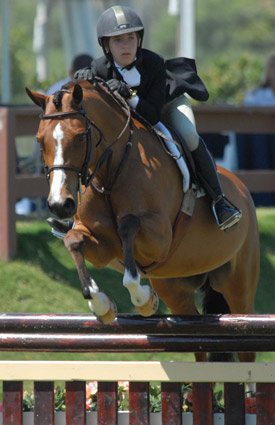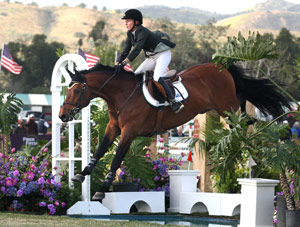By Tammy Chipko
Amateurs bring so much to this sport – it would certainly not be where it is today without them. I spoke with some very impressive Amateur riders about how they juggle their personal and professional lives while still making time for horses and competition.
A large animal vet at Specifically Equine in Buellton, CA, you are sure to see
Dr. Kirste Timm working hard at many of the southern California horse shows. She is known and respected not only for her veterinarian skills but for her love of horses. From an early age she kept horses in her backyard while going to high school in Oregon and then would spend the summers in CA riding as a working student. When Kirste went to college at Pomona then later to Vet School at UC Davis, she rode and showed Dressage horses as well as worked as a vet tech. After completing surgery residency in Colorado she moved back to CA and started full-time at Specifically Equine. Somehow she finds the time to compete in the Adult Amateur division.
How does she manage it? “I ride at obscene hours and I am fortunate that I can bring my horse to work with me at the horse shows. I am lucky to have a supportive husband and somewhat flexible hours. I am having fun and that is the most important thing to me.”
Anne Frankel rides in the Amateur Jumper divisions and currently owns two horses. Here & Now is her High A/O Jumper and Obe is a young horse that has just started his jumping career. Anne is an active owner, participating in all aspects of the care and well-being of her horses. She hauls, grooms, and prepares her horses for the ring. Not only that, but she is her own farrier!
Anne explained, “I was an Engineer for 19 years and wanted to change careers. Since riding is what I love, I wanted to do something that involved horses. Noticing how many problems start with the feet, I became very interested in the process of shoeing horses. It made sense for me to go to farrier school in Washington State not only so I could learn how to care for my own horses’ feet, but as a creative way for me to offset the horse expenses. After I had a riding accident my knee was not able to hold up to the physical pressures of shoeing too many horses, so I now only shoe my own and maybe a couple of friends’ horses. I also work as a sales rep for my husband’s toy company that allows me the flexibility to care for my horses and compete. This works well for me because I can spend time with both my husband and my horses.”
Her future plans? “The end of last year and the start of this year have certainly been the most rewarding for me in the show ring. Hero (Here & Now) has been so consistent and it has allowed me to raise the bar for myself. I love starting young horses and would like to continue to do that as well. I like to think I compete against myself and as long as I continue to progress I am happy.” Great motto, Anne!
Another Amateur with a full schedule is Tiffany Sullivan, who competes in the Amateur Owner Jumper division. Her story is also interesting. “I currently own five horses two of which I personally show and the others my trainer Santiago Ricard shows. I own Haley Farms, named after my dog. We have 60 stalls on the property that I manage and oversee. Until recently I worked full time as a child and family therapist for kids with learning disabilities and was only able to compete on the weekends. I decided to take some time off in order to finish my education and to compete in more horse shows. I’m one test away from becoming a licensed clinical social worker. I will then go back to work full-time.”
She told us a little about her involvement with kids. “Besides working as a therapist, I became very involved with an organization last year called Canyon Acres. I donated all my prize money to this organization. Canyon Acres is a unique, one-of-a-kind place in Southern California with the ability, desire and professional expertise to treat severely abused, neglected and emotionally troubled young children. Canyon Acres represents real hope to children who have been emotionally traumatized, requiring both mental health treatment and physical protection.
Besides all of this, Tiffany has more on her plate. “I have set up a foundation for people that would like to get involved in charity work through the horse industry and I am hoping that this continues to grow. I am also getting married in June of 2008.” Wow!
Lynn Walsh from Magnolia, TX, splits her time between her family, farm, competitions, and a huge amount of volunteer work. She is Chairman of the USHJA Show Standards Committee, Member of the USHJA Owners Committee and has also been President of the Texas Hunter/Jumper Organization. Lynn currently competes in the Amateur Owner Hunter division. Very involved in many aspects of the Hunter/Jumper industry, she told us about how it happened.
“After I graduated from college and got married I started competing mainly at local shows. We bought our company so I was able to afford better horses and worked my way up to showing on the A-circuit. I moved to PJP Farms (Peter Pletcher) and have had quite a bit of success through the years. I love to compete in this great sport! It had always mystified me (coming from an advertising and marketing background) why no one was marketing the horse shows. It seemed to me a great opportunity to take my background experience and mesh it with the sport I loved. I started marketing, organizing, and promoting fund raising efforts for the Pin Oak Charity Horse Show. It was fun for me to sell an event to non-horse sponsors. Especially because it helped raise so much money for TX Children’s Hospital and the Ronald McDonald House of Houston.
I became President of the Texas Hunter/Jumper organization and this helped me to learn a great deal about improving show standards. I then felt with my background and experience I could bring a lot to USHJA. It is very exciting to travel around the country and meet so many new people who really want to improve the sport. I would like to continue to promote positive changes.”
Anneliese Kannow competes in the Amateur Owner Hunter division.
Starting out in the pony division as a successful catch rider, she competed in the Pony Finals and was then successful in the Equitation arena, winning the USET Finals in 2000. Undergrad at UCSD and then to USC for her Law Degree, she passed the bar on her first try, a feat within itself.
So how does she manage working in a law firm and riding? “That was a problem and I learned quickly that I really missed riding. The amount of hours you have to put in made it impossible for me to ride. I made the decision that I wanted to ride way more than I wanted to be a lawyer.” So Annelise started tutoring kids at the shows. “I had a couple of students I was working with and decided I could expand on this and continue to pursue my riding. Most of my kids ride so everyone has the same schedule. It works great because I tutor in the afternoons or evenings, leaving me enough time to help my mom with the horses at the ranch and still compete.” She does a lot of the horse work herself. “I help everyday with feeding, grooming, cleaning stalls, etc. I haul my own horse to the shows and groom myself. I like it and it helps make it affordable.”
In her spare time, Annelise is writing a book. “It’s a hand book on The College Application Process. It is so confusing and difficult now that parents and kids are a bit at a loss. This handbook covers the application process and how to get into schools, test scores needed, and resumes. It helps the parents to guide their kids.”
We are so impressed with these Amateurs and their accomplishments in and out of our sport, we plan to continue meeting and discovering more of you! Thank you for all you do.

